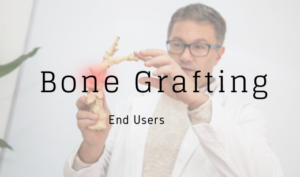What is Bone Cement?
Orthopedic implants such as hip and knee implants are usually accompanied by bone cement. Bone cement cements the gap between the prosthesis and the joint in orthopedic procedures. These cement are in use since the 1960s for the stronger fixation of implants using Polymethylmethacrylate (PMMA) as the main material. The bone cement serves an additional purpose (majorly in Hip and Knee Joints) of reducing discomfort and in weight–bearing – particularly in the hip joint to absorb the stress which occurs between the different joints. There are numerous bone cement products in India like Palacos, Simplex, Subiton, etc available at equivalent prices.

Bone cement and implants in India are registered under the “Medical devices rule” vertical by the Central Drugs Standard Control Organisation (CDSCO). This organization needs to approve all medical devices before the sale. In India, the price of bone cement is derived based on several factors.
The factors include duty, landing cost, manufacturing cost considered by all parties involved in ensuring the patient gets the best quality care – the players in the supply chain include the manufacturer, importer, distributor or dealers, etc.
Antibiotics in PMMA bone cement
As replacement surgeries grew and the total joint replacement procedures became more complicated and advanced. For example, in the knee or hip replacements, chances of bacterial infections showed an incremental presence. Consequently, this issue can be treated with bone cement. The bone cement and the antibiotic are placed at the site of surgery.
Gentamicin is one of the most commonly used antibiotics that is loaded into bone cement. It is available in the market and is used in combination with other antibiotics. Studies show that bone cement loaded with gentamicin has a longer duration of antibiotic release, essential to combat the onset of infections.
The price of anti-biotic loaded cement typically costs higher than the cement without it.
Bone Cement in Surgery
Palacos, Simplex, and Subiton bone cement are prepared before performing surgeries. It is done on a when-required basis. Due to the rapid polymerization of the monomer component with the PMMA, the bone cement has to be mixed precisely at the right temperature.
Every year million procedures are performed of this type in which bone cement is used in half of them. This number is constantly growing. Bone cement can be easily applied and is often regarded as a dependable anchorage material.
Orthopedic implant manufacturers choose to provide the bone cement by buying them from major brands, usually, ones like Palacos, Simplex, and Subiton, while some leave the decision to the distributors or dealers. In India, distributors usually provide bone cement along with orthopedic implants to hospitals.
Types of Bone Cement – Based on Viscosity
Viscosity is an important factor while considering the user capabilities of the bone cement, here the cement resisting the flow is a prominent factor. This affects the fixation of the cement, like how much can it penetrate the pores of weak bones.
Bone cement is of three types: Low, Medium, and High viscosity.
Subiton, Palacos, and Simplex manufacture all types of viscosity – usually, high viscosity cement is used for hip and knee replacements while low viscosity cement is used in the spine or vertebral column. Each viscosity level has its function and depending on the place of application and procedure.
Bone Cement Imported by Morulaa

Morulaa Healthtech Pvt Ltd. is the licensed importer of Subiton.
Subiton, also known as Laboratorios SL, is an Argentine firm that has been a world leader in medical devices since 1957. These products are manufactured in environment-conscious facilities, serves over 110 nations. It has obtained certification of its products in India.
Subiton RO / Subiton GUN
It is a manually applied cement. They are designed specifically for hip/general surgeries. Subiton RO cement shows great fatigue resisting quality, as a result, has improved implant fixation performance. Subiton GUN is a syringe application cement applied using a gun.
Advantages
- The dough is easy to use, transitions to plastic quickly and has a long working time.
- The mechanical qualities of the cement are exceptional.
Subiton G /Subiton GUN G
It is a manual application radiopaque bone cement sterile with 1.25% of the antibiotic Gentamicin.
It is used in the prevention of infections, revisions, or high-risk patients because of its ability to act against a wide range of microbes and long-lasting antibiotic release.
Subiton GUN G is a syringe application cement applied using a GUN, a low viscosity cement with a Gentamicin antibiotic.
Advantages
- Dough that is easy to use and has a quick transition to plastic.
- Excellent mechanical characteristics.
Subiton VTP
Vertebroplasty is the injection of bone cement into the spine or vertebral column. It relieves spinal pain and improves mobility.
Subiton VTP is an acrylic bone cement made to fill the vertebral column which has undergone structural changes. It cannot be applied manually and Set Subiton VTP Integral, a cement application system with a disposable syringe helps in the application.
Advantages
- Injected using vertebroplasty injecting devices.
- Maintenance of low temperature.
- Radiopacity (opacity towards radiation making it visible on X-rays) is quite high (40 percent barium sulfate).
- Prolonged operating hours.
- The initial low viscosity makes the transfer to application devices easier.
Joint Spacers
Antibiotic joint spacers are devices that temporarily treat joints after arthroplasty surgery and bones with bacterial infections.
The two-stage revision of total knee arthroscopy is done to remove the infection and also simultaneously producing healthy tissue ready for the new implant to be fixed. The implant present is removed, the bone joint is cleaned and then the temporary spacer is fixed.
Subiton Hip Spacer
Subiton Spacer is used as a temporary solution to help the healing process of prosthetic components in a joint that is infected. The benefit of using the spacer is that increases patient’s quality of life during their treatment. It also helps to make revision surgeries while setting the prosthesis and continued throughout the patient’s recovery time.
Advantages
- Efficient antibiotic release.
- The spacer has a nucleus that is metallic which makes sure it resists physiological mechanical stress.
- Subiton Hip spacer limits the femur movement which is useful in later stages of revision procedures.
- Early patient recovery due to ease of movement.
Subiton Knee Spacer
Knee Spacer just like hip spacer serves the same purpose but in the knee. It also acts as a temporary solution to remove bacterial infections and help in the revision procedures.
Advantages
- Efficient antibiotic release.
- Keeps space together.
- Allows joint movement to improve the well-being of patients.
- Revision is easier and prevents immobilization adherence
Conclusion:
The above article deals with bone cement, the process involved, types, brands, and how it is used. Subiton products are of high-quality, provided at a competitive price. Morulaa’s imported cement is well suited to give stability to implants used in total knee replacement and total hip replacement surgeries.
This article is intended to give product information on Subiton bone cement. To know more about the product details, brochure please visit products.morulaa.com.
Morulaa is a turnkey solution provider with an in-house Regulatory Consultancy team to conduct registrations of medical devices. Morulaa provides high-quality and professional services for Regulatory Consultancy and we aim at developing long-term relationships for the Indian Market.







